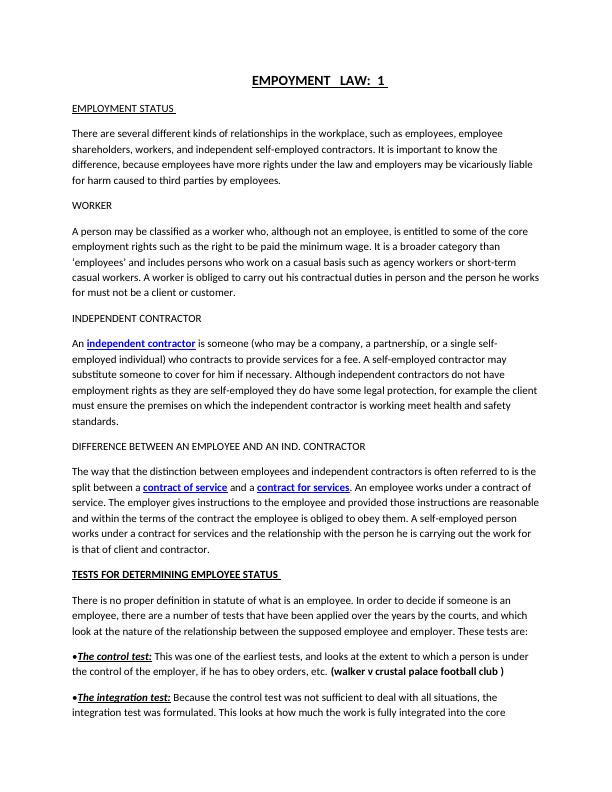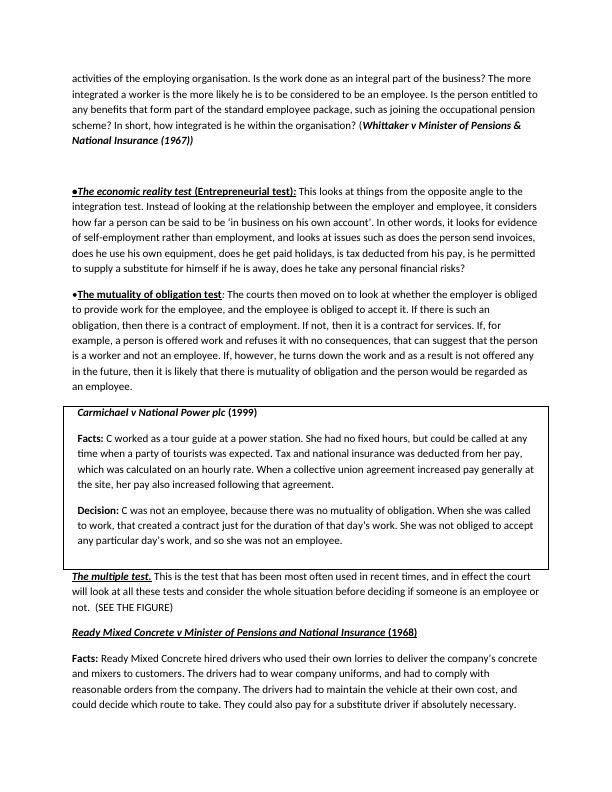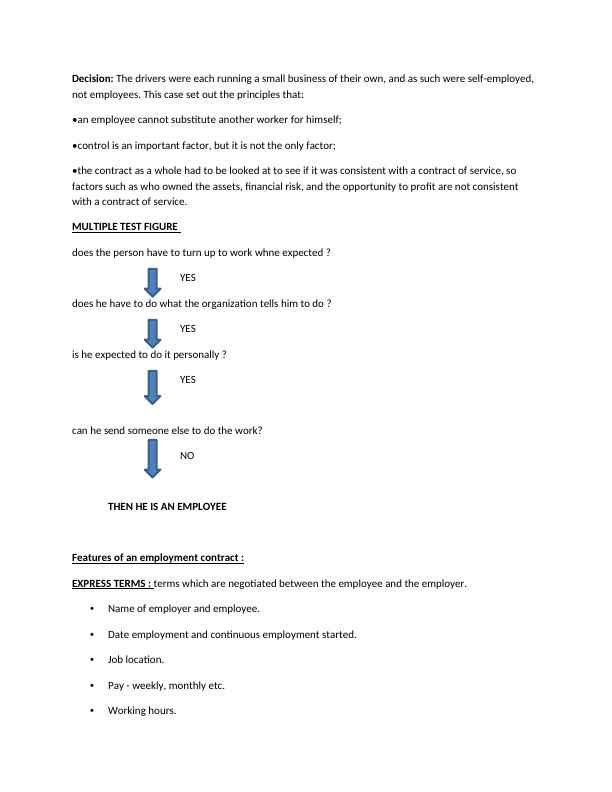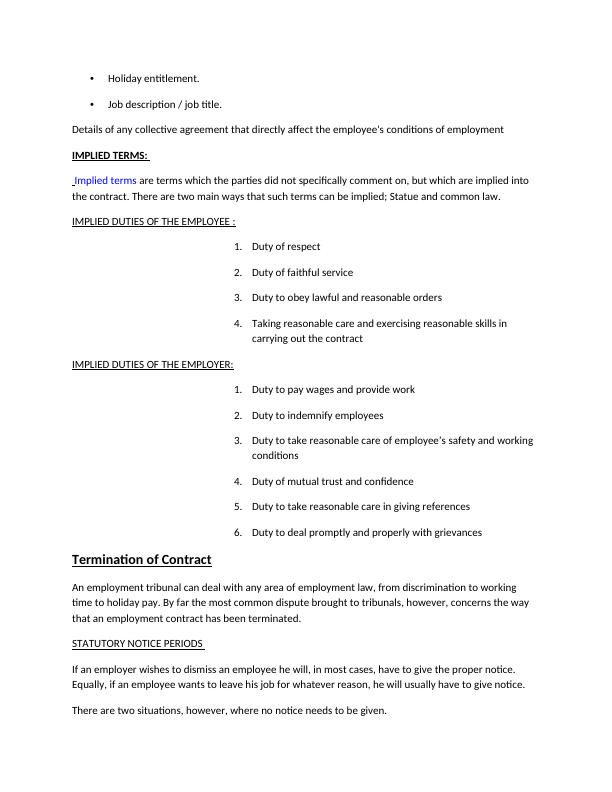Empoyment Law Assignment PDF
Added on 2021-11-18
13 Pages4843 Words83 Views
EMPOYMENT LAW: 1
EMPLOYMENT STATUS
There are several different kinds of relationships in the workplace, such as employees, employee
shareholders, workers, and independent self-employed contractors. It is important to know the
difference, because employees have more rights under the law and employers may be vicariously liable
for harm caused to third parties by employees.
WORKER
A person may be classified as a worker who, although not an employee, is entitled to some of the core
employment rights such as the right to be paid the minimum wage. It is a broader category than
‘employees’ and includes persons who work on a casual basis such as agency workers or short-term
casual workers. A worker is obliged to carry out his contractual duties in person and the person he works
for must not be a client or customer.
INDEPENDENT CONTRACTOR
An independent contractor is someone (who may be a company, a partnership, or a single self-
employed individual) who contracts to provide services for a fee. A self-employed contractor may
substitute someone to cover for him if necessary. Although independent contractors do not have
employment rights as they are self-employed they do have some legal protection, for example the client
must ensure the premises on which the independent contractor is working meet health and safety
standards.
DIFFERENCE BETWEEN AN EMPLOYEE AND AN IND. CONTRACTOR
The way that the distinction between employees and independent contractors is often referred to is the
split between a contract of service and a contract for services. An employee works under a contract of
service. The employer gives instructions to the employee and provided those instructions are reasonable
and within the terms of the contract the employee is obliged to obey them. A self-employed person
works under a contract for services and the relationship with the person he is carrying out the work for
is that of client and contractor.
TESTS FOR DETERMINING EMPLOYEE STATUS
There is no proper definition in statute of what is an employee. In order to decide if someone is an
employee, there are a number of tests that have been applied over the years by the courts, and which
look at the nature of the relationship between the supposed employee and employer. These tests are:
•The control test: This was one of the earliest tests, and looks at the extent to which a person is under
the control of the employer, if he has to obey orders, etc. (walker v crustal palace football club )
•The integration test: Because the control test was not sufficient to deal with all situations, the
integration test was formulated. This looks at how much the work is fully integrated into the core
EMPLOYMENT STATUS
There are several different kinds of relationships in the workplace, such as employees, employee
shareholders, workers, and independent self-employed contractors. It is important to know the
difference, because employees have more rights under the law and employers may be vicariously liable
for harm caused to third parties by employees.
WORKER
A person may be classified as a worker who, although not an employee, is entitled to some of the core
employment rights such as the right to be paid the minimum wage. It is a broader category than
‘employees’ and includes persons who work on a casual basis such as agency workers or short-term
casual workers. A worker is obliged to carry out his contractual duties in person and the person he works
for must not be a client or customer.
INDEPENDENT CONTRACTOR
An independent contractor is someone (who may be a company, a partnership, or a single self-
employed individual) who contracts to provide services for a fee. A self-employed contractor may
substitute someone to cover for him if necessary. Although independent contractors do not have
employment rights as they are self-employed they do have some legal protection, for example the client
must ensure the premises on which the independent contractor is working meet health and safety
standards.
DIFFERENCE BETWEEN AN EMPLOYEE AND AN IND. CONTRACTOR
The way that the distinction between employees and independent contractors is often referred to is the
split between a contract of service and a contract for services. An employee works under a contract of
service. The employer gives instructions to the employee and provided those instructions are reasonable
and within the terms of the contract the employee is obliged to obey them. A self-employed person
works under a contract for services and the relationship with the person he is carrying out the work for
is that of client and contractor.
TESTS FOR DETERMINING EMPLOYEE STATUS
There is no proper definition in statute of what is an employee. In order to decide if someone is an
employee, there are a number of tests that have been applied over the years by the courts, and which
look at the nature of the relationship between the supposed employee and employer. These tests are:
•The control test: This was one of the earliest tests, and looks at the extent to which a person is under
the control of the employer, if he has to obey orders, etc. (walker v crustal palace football club )
•The integration test: Because the control test was not sufficient to deal with all situations, the
integration test was formulated. This looks at how much the work is fully integrated into the core

activities of the employing organisation. Is the work done as an integral part of the business? The more
integrated a worker is the more likely he is to be considered to be an employee. Is the person entitled to
any benefits that form part of the standard employee package, such as joining the occupational pension
scheme? In short, how integrated is he within the organisation? (Whittaker v Minister of Pensions &
National Insurance (1967))
• The economic reality test (Entrepreneurial test) : This looks at things from the opposite angle to the
integration test. Instead of looking at the relationship between the employer and employee, it considers
how far a person can be said to be ‘in business on his own account’. In other words, it looks for evidence
of self-employment rather than employment, and looks at issues such as does the person send invoices,
does he use his own equipment, does he get paid holidays, is tax deducted from his pay, is he permitted
to supply a substitute for himself if he is away, does he take any personal financial risks?
•The mutuality of obligation test: The courts then moved on to look at whether the employer is obliged
to provide work for the employee, and the employee is obliged to accept it. If there is such an
obligation, then there is a contract of employment. If not, then it is a contract for services. If, for
example, a person is offered work and refuses it with no consequences, that can suggest that the person
is a worker and not an employee. If, however, he turns down the work and as a result is not offered any
in the future, then it is likely that there is mutuality of obligation and the person would be regarded as
an employee.
Carmichael v National Power plc (1999)
Facts: C worked as a tour guide at a power station. She had no fixed hours, but could be called at any
time when a party of tourists was expected. Tax and national insurance was deducted from her pay,
which was calculated on an hourly rate. When a collective union agreement increased pay generally at
the site, her pay also increased following that agreement.
Decision: C was not an employee, because there was no mutuality of obligation. When she was called
to work, that created a contract just for the duration of that day’s work. She was not obliged to accept
any particular day’s work, and so she was not an employee.
The multiple test. This is the test that has been most often used in recent times, and in effect the court
will look at all these tests and consider the whole situation before deciding if someone is an employee or
not. (SEE THE FIGURE)
Ready Mixed Concrete v Minister of Pensions and National Insurance (1968)
Facts: Ready Mixed Concrete hired drivers who used their own lorries to deliver the company’s concrete
and mixers to customers. The drivers had to wear company uniforms, and had to comply with
reasonable orders from the company. The drivers had to maintain the vehicle at their own cost, and
could decide which route to take. They could also pay for a substitute driver if absolutely necessary.
integrated a worker is the more likely he is to be considered to be an employee. Is the person entitled to
any benefits that form part of the standard employee package, such as joining the occupational pension
scheme? In short, how integrated is he within the organisation? (Whittaker v Minister of Pensions &
National Insurance (1967))
• The economic reality test (Entrepreneurial test) : This looks at things from the opposite angle to the
integration test. Instead of looking at the relationship between the employer and employee, it considers
how far a person can be said to be ‘in business on his own account’. In other words, it looks for evidence
of self-employment rather than employment, and looks at issues such as does the person send invoices,
does he use his own equipment, does he get paid holidays, is tax deducted from his pay, is he permitted
to supply a substitute for himself if he is away, does he take any personal financial risks?
•The mutuality of obligation test: The courts then moved on to look at whether the employer is obliged
to provide work for the employee, and the employee is obliged to accept it. If there is such an
obligation, then there is a contract of employment. If not, then it is a contract for services. If, for
example, a person is offered work and refuses it with no consequences, that can suggest that the person
is a worker and not an employee. If, however, he turns down the work and as a result is not offered any
in the future, then it is likely that there is mutuality of obligation and the person would be regarded as
an employee.
Carmichael v National Power plc (1999)
Facts: C worked as a tour guide at a power station. She had no fixed hours, but could be called at any
time when a party of tourists was expected. Tax and national insurance was deducted from her pay,
which was calculated on an hourly rate. When a collective union agreement increased pay generally at
the site, her pay also increased following that agreement.
Decision: C was not an employee, because there was no mutuality of obligation. When she was called
to work, that created a contract just for the duration of that day’s work. She was not obliged to accept
any particular day’s work, and so she was not an employee.
The multiple test. This is the test that has been most often used in recent times, and in effect the court
will look at all these tests and consider the whole situation before deciding if someone is an employee or
not. (SEE THE FIGURE)
Ready Mixed Concrete v Minister of Pensions and National Insurance (1968)
Facts: Ready Mixed Concrete hired drivers who used their own lorries to deliver the company’s concrete
and mixers to customers. The drivers had to wear company uniforms, and had to comply with
reasonable orders from the company. The drivers had to maintain the vehicle at their own cost, and
could decide which route to take. They could also pay for a substitute driver if absolutely necessary.

Decision: The drivers were each running a small business of their own, and as such were self-employed,
not employees. This case set out the principles that:
•an employee cannot substitute another worker for himself;
•control is an important factor, but it is not the only factor;
•the contract as a whole had to be looked at to see if it was consistent with a contract of service, so
factors such as who owned the assets, financial risk, and the opportunity to profit are not consistent
with a contract of service.
MULTIPLE TEST FIGURE
does the person have to turn up to work whne expected ?
YES
does he have to do what the organization tells him to do ?
YES
is he expected to do it personally ?
YES
can he send someone else to do the work?
NO
THEN HE IS AN EMPLOYEE
Features of an employment contract :
EXPRESS TERMS : terms which are negotiated between the employee and the employer.
•Name of employer and employee.
•Date employment and continuous employment started.
•Job location.
•Pay - weekly, monthly etc.
•Working hours.
not employees. This case set out the principles that:
•an employee cannot substitute another worker for himself;
•control is an important factor, but it is not the only factor;
•the contract as a whole had to be looked at to see if it was consistent with a contract of service, so
factors such as who owned the assets, financial risk, and the opportunity to profit are not consistent
with a contract of service.
MULTIPLE TEST FIGURE
does the person have to turn up to work whne expected ?
YES
does he have to do what the organization tells him to do ?
YES
is he expected to do it personally ?
YES
can he send someone else to do the work?
NO
THEN HE IS AN EMPLOYEE
Features of an employment contract :
EXPRESS TERMS : terms which are negotiated between the employee and the employer.
•Name of employer and employee.
•Date employment and continuous employment started.
•Job location.
•Pay - weekly, monthly etc.
•Working hours.

•Holiday entitlement.
•Job description / job title.
Details of any collective agreement that directly affect the employee's conditions of employment
IMPLIED TERMS:
Implied terms are terms which the parties did not specifically comment on, but which are implied into
the contract. There are two main ways that such terms can be implied; Statue and common law.
IMPLIED DUTIES OF THE EMPLOYEE :
1. Duty of respect
2. Duty of faithful service
3. Duty to obey lawful and reasonable orders
4. Taking reasonable care and exercising reasonable skills in
carrying out the contract
IMPLIED DUTIES OF THE EMPLOYER:
1. Duty to pay wages and provide work
2. Duty to indemnify employees
3. Duty to take reasonable care of employee’s safety and working
conditions
4. Duty of mutual trust and confidence
5. Duty to take reasonable care in giving references
6. Duty to deal promptly and properly with grievances
Termination of Contract
An employment tribunal can deal with any area of employment law, from discrimination to working
time to holiday pay. By far the most common dispute brought to tribunals, however, concerns the way
that an employment contract has been terminated.
STATUTORY NOTICE PERIODS
If an employer wishes to dismiss an employee he will, in most cases, have to give the proper notice.
Equally, if an employee wants to leave his job for whatever reason, he will usually have to give notice.
There are two situations, however, where no notice needs to be given.
•Job description / job title.
Details of any collective agreement that directly affect the employee's conditions of employment
IMPLIED TERMS:
Implied terms are terms which the parties did not specifically comment on, but which are implied into
the contract. There are two main ways that such terms can be implied; Statue and common law.
IMPLIED DUTIES OF THE EMPLOYEE :
1. Duty of respect
2. Duty of faithful service
3. Duty to obey lawful and reasonable orders
4. Taking reasonable care and exercising reasonable skills in
carrying out the contract
IMPLIED DUTIES OF THE EMPLOYER:
1. Duty to pay wages and provide work
2. Duty to indemnify employees
3. Duty to take reasonable care of employee’s safety and working
conditions
4. Duty of mutual trust and confidence
5. Duty to take reasonable care in giving references
6. Duty to deal promptly and properly with grievances
Termination of Contract
An employment tribunal can deal with any area of employment law, from discrimination to working
time to holiday pay. By far the most common dispute brought to tribunals, however, concerns the way
that an employment contract has been terminated.
STATUTORY NOTICE PERIODS
If an employer wishes to dismiss an employee he will, in most cases, have to give the proper notice.
Equally, if an employee wants to leave his job for whatever reason, he will usually have to give notice.
There are two situations, however, where no notice needs to be given.

End of preview
Want to access all the pages? Upload your documents or become a member.
Related Documents
Differences between Contract of Service and Contract for Serviceslg...
|8
|1436
|281
Case Study on Yum Yum Pizzalg...
|9
|1959
|266
The Employment Status - Assignmentlg...
|8
|2046
|84
Difference between employee and independent contractor | Lawlg...
|7
|1133
|312
Difference between Employees, Workers, and Independent Contractorslg...
|8
|2035
|26
Difference between employees and self-employed contractors with reference to Pimlico Plumbers Ltd v Smith [2018] UKSC 29lg...
|11
|3078
|174